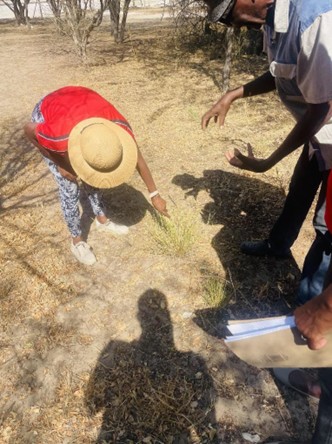Filed Trip Data Collection Report: Indigenous Ecological Knowledge for Climate Early Warning and Preparedness in Northern Namibia
Martha Akawa (University of Namibia) and Romie Nghitevelekwa (University of Namibia)
On November 4, 2024, we traveled to the Omuthiya Constituency in the Oshikoto Region to conduct fieldwork for the research project on the role of indigenous ecological knowledge in climate early warning and preparedness in northern Namibia’s floodplain, also known as the Cuvelai Basin or Owambo.
The main aims of the study were to:
- Investigate the developed responsive knowledge systems through their interaction with the environment.
- Identify the systems used in reading and interpreting ecological signs to predict climatic events such as floods and droughts.
- Identify the indigenous ecological knowledge used to foretell imminent droughts in northern Namibia’s floodplain.
- Examine how these traditional practices are used to build drought preparedness and resilience.
Our first stop was at the Omuthiya Constituency Councillor’s office, who also serves as the Chairperson of the Oshikoto Regional Council. This was part of the established gatekeeping protocol to report the presence of the researchers in the area and to assist with ensuring trust among the research participants, who would feel at ease with the researchers if they have gone through the Councillor’s office. In our study sample, we targeted the elderly in the Constituency, and the Office of the Councillor was very instrumental in referring us to the elderly populations in the Constituency – thus we use snowball sampling method. In addition to the Councillor, as the government institutional representative, we also interviewed the agricultural extension officers at the Okashana Rural Development Center in Omuthiya, which is under the Ministry of Urban and Rural Development. This center has community outreach programmes in agriculture and food production as one of its objectives.
Other participants included the farmers (elderly) in the Constituency – both men and women. The methods used to gather information included semi-structured interviews, focus group discussions and all these are complemented by the review of secondary data sources.
In totality, the interviews were conducted with men and women of different age groups and social statuses. Some were communal subsistence farmers, while others held positions such as headman, liaison officer, extension officers, and constituency councillor. One interview was conducted with a couple who own and run a rural household.

It was an enriching and exciting process for both the researchers and the participants as they recounted the traditional knowledge systems used to predict weather and climatic changes. They provided specific examples from communities in northern Namibia, and at times from their own specific fields. They were particularly pleased that there is still interest in ecological signs, which presents an opportunity for recording them for future use. They also highlighted challenges, such as the mixed signals they are currently receiving (indicating the impact of climate change on their traditional knowledge) and the fact that the younger generation cannot readily interpret these signs. They emphasized the ongoing need to observe and understand the changing trends.

Overall, the findings indicate that the community of the Omuthiya Constituency still relies on ecological warnings to prepare their fields (determining when and which part of the field to start preparing, and when and which seeds to plant) and manage food resources (deciding on the amount and frequency of consumption, and whether or not to sell surplus). These signs are ‘read’ through biotic and abiotic indicators. It is important to note that these findings cannot be generalized to other parts of Owambo due to the geographical variations within the area.
We are currently drafting a Book Chapter from the field data.
Acknowledgement: We are thankful to Kyoto University, through Professor Takada, for the support provided to make this fieldwork a reality. We look forward to further engagement and finally signing an MOU for the two Universities for further collaboration.
